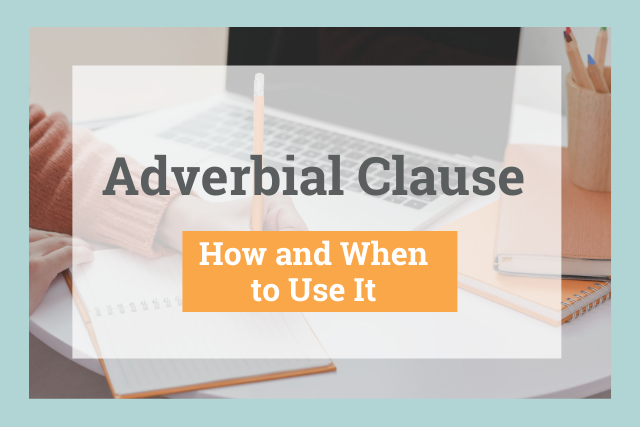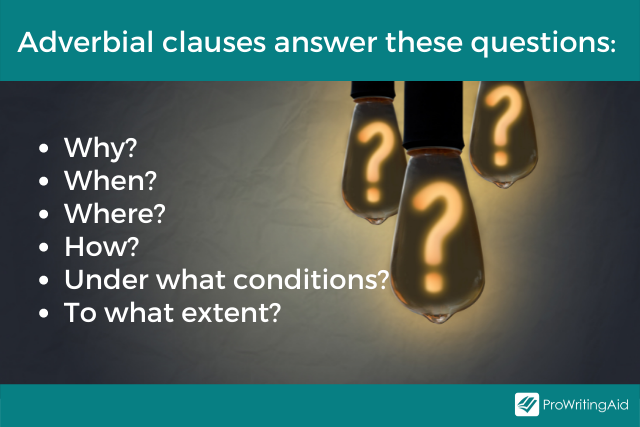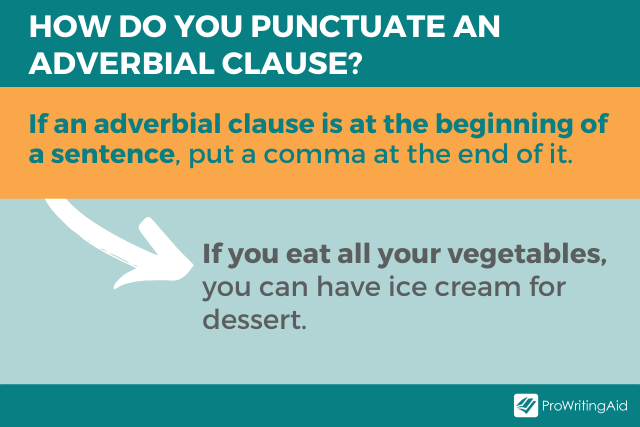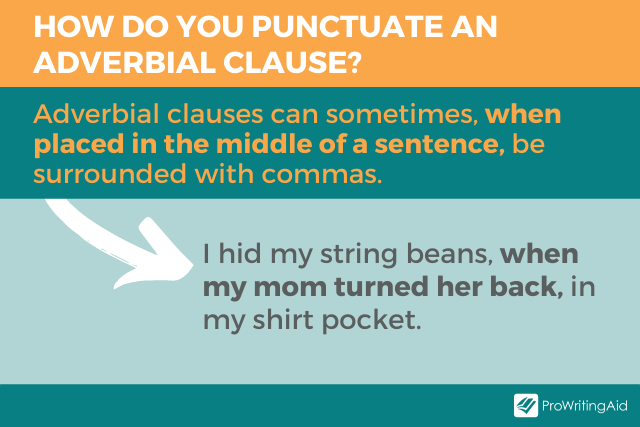Adverbial Clause: Definition, Meaning and Examples

“You can’t go.”
“Make the announcement!”
“I see her.”
Wait—what? I don’t know what's going on!
Why can’t I go? When should I make the announcement? Where do you see her?
I need answers! Can someone please send some adverbial clauses?

What Is an Adverbial Clause?
An adverbial clause, also called an adverb clause or adverb phrase, is a group of words that contains a subject and a verb.
Just like adverbs, adverbial clauses modify verbs, adjectives, or other adverbs. But where an adverb is just one word, an adverbial clause is a group of words.
Adverb:
- I went to the store earlier.
The adverb “earlier” provides information about when I went (to the store).
Adverbial clause:
- I went to the store before you were awake.
The adverbial clause “before you were awake” also provides information about when I went (to the store).
As you can see, adverbs and adverbial clauses function in the same way.

Adverbs and adverbial clauses can be used to several questions:
- Why?
- When?
- Where?
- How?
- Under what conditions?
- To what extent?
If we add adverbial clauses (in bold) to the examples above, we can find out...
Why you can’t go:
- You can’t go because you didn’t buy a ticket.
When to make the announcement:
- After everyone is seated, make the announcement.
Where I see her:
- I see her everywhere I go!
What Characteristics Do All Adverbial Clauses Have?

All adverbial clauses have three things in common:
They are dependent clauses.
They start with a subordinating conjunction.
They are flexible: they can make sense in the beginning, middle, or end of sentence.
Adverbial Clauses Are Dependent Clauses
A clause is a group of words that has a subject and a verb. There are two main categories of clauses: independent clauses and dependent clauses (also called subordinate clauses).
An independent clause is a complete, simple sentence. That means it has a subject, a verb, and a complete thought. An independent clause makes sense on its own.
- I hope it’s sunny on Saturday.
- My sister yells at me.
- Turn the oven off.
A subordinate clause (also called dependent clause) has a subject and a verb but it does not express a complete thought. A dependent clause cannot stand on its own as a sentence.
- Because the party is outside.
- Whenever I enter her room without knocking.
- After you’ve finished cooking.
In order to make sense, these dependent adverb clauses need connection to an independent clause, like this:

- I hope it’s sunny on Saturday because the party is outside.
- My sister yells at me whenever I enter her room without knocking.
- After you’ve finished cooking, turn the oven off.
Adverbial Clauses Start with Subordinating Conjunctions
Just as all adverbial clauses are subordinate clauses, they also all start with words called subordinating conjunctions.
Subordinating conjunctions go at the start of subordinate adverbial clauses. They connect the subordinate clause to an independent clause by signaling and establishing a relationship between the information in both clauses. It’s not as confusing as it sounds.
Like many grammar issues, this concept is easier to understand through observation than explanation.
Take the examples from the previous section. Each of the adverbial clauses starts with a subordinating conjunction.
- I hope it’s sunny on Saturday because the party is outside.
Because signals the cause-effect relationship between the independent clause and adverbial clause, explaining why the speaker hopes it’s going to be sunny.
- My sister yells at me whenever I enter her room without knocking.
Whenever signals a “time” relationship, explaining when the sister yells.
- After you’ve finished cooking, turn the oven off.
After signals a time relationship, explaining when to turn the oven off.
At this point, you’ve probably noticed that subordinating conjunctions address many of the same issues adverbs and adverbial clauses do.
These words signal relationships in time (when), place (where), conditions (why/how), and cause and effect (why), among others. Very adverb-y!
Common Subordinating Conjunctions
| Although | After | As if | As long as | As much as |
|---|---|---|---|---|
| Before | Because | Even | Even if | Even though |
| If | If only | In order to | Now that | Once |
| Provided | So that | Since | Though | Until |
| Unless | Whenever | Wherever | Whether | While |
Where Can I Use an Adverbial Clause in a Sentence?
Adverbial clauses are not snobs; they’ll live anywhere in a sentence—beginning, middle, or end. Unlike some other clauses, shifting the placement of an adverbial clause doesn’t wreak grammatical havoc on a sentence.
For some examples, we’ll rely on the help of five-year-old Sam. Through Sam’s story, you’ll recognize and appreciate the flexibility of the adverbial clause.
Sam, although only five, is very clever.
Although only five, Sam is very clever.
Sam is very clever although only five.
Sam’s parents, since they want their child to grow strong, feed him a healthy diet.
Since they want their child to grow strong, Sam’s parents feed him a healthy diet.
Sam’s parents feed him a healthy diet since they want him to grow strong.
Sam, even though he loves his parents, hates vegetables and prefers ice cream.
Even though he loves his parents, Sam hates vegetables and prefers ice cream.
Sam hates vegetables and prefers ice cream even though he loves his parents.
See that? The adverbial clause is quite the shapeshifter, providing sentence structure variety.
Adverbial clauses aren’t the only help for avoiding monotonous sentence structure. ProWritingAid’s Sentence Structure Report will alert you to overused sentence patterns and offer suggestions.

Try the Sentence Structure Report with a free ProWritingAid account.
How Do You Punctuate an Adverbial Clause?
The rules for punctuating adverbial clauses change depending on where the clause is in the sentence. Sometimes they require a comma or two—but how do you know?
Let’s take a look at how to punctuate adverbial clauses.
1. Beginning of the Sentence

If an adverbial clause is at the beginning of a sentence, put a comma at the end of it.
In this placement, the adverbial clause—the dependent clause—comes before the independent clause. It’s an introductory clause.
2. Middle of the Sentence

Adverbial clauses, when placed in the middle of a sentence, are surrounded with commas.
In this placement, the adverbial clause “interrupts” the independent clause and is set off with commas.
3. End of the Sentence

No comma is needed for adverbial clauses at the end of a sentence since they follow the independent clause.
In this placement, the dependent adverbial clause comes after the independent clause and the subordinating conjunction is enough to hold the two clauses together.
Examples of How to Punctuate Adverbial Clauses
Looking for more examples? Young Sam has one more thing to teach us about adverbial clauses. As you experience this episode from his life, observe the adverbial clauses and review how they are punctuated.
(Scene opens to Sam’s kitchen table. Mom begins the conversation; Sam takes over in sentence three)
- If you eat all your vegetables, you can have ice cream for dessert.
- Since you chose to throw your vegetables on the floor, you cannot have ice cream.
- If I can find a way to fake eating vegetables, I’ll get ice cream next time.
- I hid my string beans, when my mom turned her back, in my shirt pocket.
- I ate my delicious ice cream after I finished “all” my dinner.
- Although it was smart, my plan wasn’t foolproof.
- When my dad did the laundry, he found my pocket full of beans.
- Now I won’t be having ice cream unless my grandma comes over to watch me.
Well, poor Sam’s ice cream quest is a bust (at least until grandma shows up), but I have confidence that your quest for understanding commas and adverbial clauses was more successful!
Why Should I Use Adverbial Clauses in My Writing?
Adverbial clauses may be dependent, but they are powerful grammatical constructions. No, they can’t answer your questions about the meaning of life, but they can answer plenty of other ones. Use adverbial clauses to add specificity and variety to your sentences!